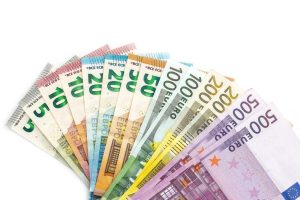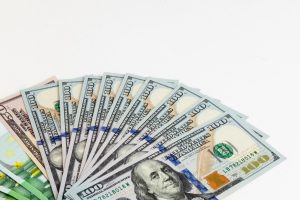EURO VAULTS TO ONE-MONTH HIGH AFTER TRUMP U-TURN ON EU TARIFFS
The euro hit a one-month high against the dollar on Monday, after U.S. President Donald Trumpbacked down from threatened 50% duties on European Union shipments from June 1, after the bloc asked for time to “reach a good deal.” The dollar continued its decline against a broad swathe of other currencies as Trump’s policy reversals, as well as his sweeping spending and tax-cut bill currently in legislation, turned investors off from U.S. assets. “The ‘Sell America’ theme, which obviously was the dominant theme back in April, is back on show,” said Ray Attrill, head of FX research at National Australia Bank. “Markets have probably taken the view – and probably rightly so – that where we land eventually on a tariff situation between the U.S. and the EU is not going to be at 50%, but how we get there is frankly anybody’s guess at the moment.” The euro climbed as much as 0.55% to reach $1.1418 for the first time since April 29. It was last up 0.36% on the day at $1.1394, bringing gains for the year so far to 10%. Sterling rose by 0.39% to its highest level since February 2022 and was last up 0.25% on the day at $1.3574. The safe-haven yen and Swiss franc were overall weak as market sentiment improved, but they still appreciated against the U.S. dollar. The greenback slipped as much as 0.24% to 142.23 yen , the lowest level this month, and edged to a 2-1/2-week low of 0.8193 franc . The U.S. dollar index , which tracks the currency against six other currencies, sank 0.15% to 98.93, extending last week’s 1.9% decline.

DOLLAR, STOCKS FALL AS TRUMP TARGETS EUROPE AND APPLE IN TARIFF THREATS
Major stock indexes and the dollar eased on Friday after U.S. President Donald Trump unleashed his latest trade threats, recommending 50% tariffs on European Union imports from June 1 and considering a 25% tariff on any Apple iPhones made outside the U.S. Shares of Apple (AAPL.O), opens new tab ended 3% lower, while the three major U.S. stock indexes finished weaker but off session lows. European shares also ended lower. The dollar index , which measures the greenback against a basket of currencies, hit a three-week trough. For the week, the dollar was down 1.9%, on track for its biggest weekly percentage decline since early April. The dollar sank 1% versus the Japanese yen , while the euro rose 0.8% against the dollar. Government bonds in the United States and Europe climbed on safe-haven buying after sustaining heavy pressure this week from rising concerns about Trump’s tax cuts and the White House’s ballooning debt pile. Trump said in a post on his Truth Social network: “The European Union, which was formed for the primary purpose of taking advantage of the United States on TRADE, has been very difficult to deal with.” This was the latest event in a jittery week for global markets after Moody’s downgraded the U.S. credit rating late last Friday and the U.S. House of Representatives narrowly approved Trump’s sweeping tax cuts on Thursday. The new tax-cut bill is expected to add almost $4 trillion to the U.S. federal government’s $36 trillion debt pile. “Tariffs are back at the forefront,” said Oliver Pursche, senior vice president and advisor for Wealthspire Advisors in Westport, Connecticut.

POUND TRADES AT HIGHEST SINCE EARLY 2022, BOOSTED BY UNEASE OVER US ASSETS
The pound traded at its highest in over three years on Friday, heading for its largest weekly gain against the dollar since early April, thanks in part to unexpectedly robust UK retail sales data and to ongoing investor unease around U.S. assets. Sunny weather boosted British consumer spending in April. Retail sales volumes jumped by 1.2% month-on-month, the Office for National Statistics said on Friday after a downwardly revised 0.1% increase in March. Economists had forecast a rise of 0.2%. Sterling has gained 1.5% this week and on Friday hit a high of $1.3468, the most since February 24, 2022, when Russia invaded Ukraine, sparking a global flood of money into safe-havens like the dollar.Just over three years later and the investor nervousness about the outlook for the global economy that would normally have funnelled cash into the dollar is sucking capital out of U.S. markets, which are now the epicentre of the uncertainty. U.S. President Donald Trump’s erratic application of hefty tariffs on trading partners – even with the pauses and outlines of deals that have ensued – have generated the most uncertainty among investors in years. To boot, Trump’s sweeping tax and spending bill that will strain U.S. government finances even further by adding trillions of dollars in debt, has made investors wary of long-dated government bonds, even those outside elsewhere, such as UK gilts. Higher gilt yields have made sterling more attractive to non-UK investors, but the concerns around public finances mean Britain has the highest government borrowing rates in the developed world, with 30-year gilt yields topping 5.5% on Friday, despite news that energy bills were set to drop. “This is a sign that the market remains wary of lending to the UK while the government still does not have control of public spending, even if the decline in the energy price cap is adding downward pressure on short term yields this morning,” Kathleen Brooks, XTB research director, said.
STERLING HITS HIGHEST SINCE 2022 AFTER RED-HOT UK INFLATION DATA
The pound hit its highest in three years on Wednesday, catching a brief lift from data that showed UK consumer inflation picked up faster than expected in April, which reduces the Bank of England’s ability to quickly cut rates to protect growth. Consumer prices rose at a rate of 3.5% in April from 2.6% in March, the Office for National Statistics said, the highest since January 2024 and the largest increase since 2022 when inflation was rocketing. Sterling rose as much as 0.58% to $1.347, its highest since February 2022, although it was broadly steady against the euro , trading at 84.325 pence. UK finance minister Rachel Reeves said she was “disappointed” by the data. “I know cost of living pressures are still weighing down on working people,” she said in a statement. A Reuters poll of economists had pointed to a reading of 3.3% in April while the Bank of England earlier this month projected inflation of 3.4%. There had been an expectation for a sharper pick-up in prices last month, thanks to increases in water, gas and electricity bills. A rise in air fares contributed to the hot data print, the ONS said. Worryingly for the BoE, services inflation, which captures domestic price pressures, rose by 5.4% in April, above even the highest forecasts in a Reuters poll for an increase of 4.8% and beyond the BoE’s forecast for a reading of 5% last month. Wednesday’s data will add to unease among Monetary Policy Committee (MPC) members over the outlook for Britain’s economy, which grew strongly in early 2025 but is likely to slow in the second half of the year.

STOCKS, DOLLAR DROP, YIELDS GAIN; SOFT DEMAND IN 20-YR TREASURY AUCTION
Major stock indexes and the dollar fell on Wednesday as investors worried about a deteriorating U.S. fiscal outlook and Treasury yields climbed following a poorly received sale of 20-year U.S. bonds. The U.S. Treasury Department saw soft demand for the $16 billion sale of 20-year bonds, which reinforced the view that investors are shying away from U.S. assets. The three major U.S. stock indexes ended down more than 1% each. The dollar also fell broadly. At the same time, concerns continued about U.S. President Donald Trump’s efforts to push through a tax-cutting bill that could worsen the debt load by $3 trillion to $5 trillion. Investor sentiment has been fragile since Moody’s late last Friday downgraded the United States’ credit rating, stoking concerns about the country’s $36 trillion debt pile. Republicans are still divided over the details of the tax legislation, which would extend and add to Trump’s 2017 tax cuts. There are also concerns about a lack of progress on U.S. trade talks with trading partners pressing Washington to ease or eliminate its tariffs. “There’s no doubt the (U.S.) deficit has grown larger,” said Tim Ghriskey, senior portfolio strategist at Ingalls & Snyder in New York. “Is there a chance that Trump over his term will bring that down? I would be surprised.” “What we’re really in is this period that’s sort of a waiting game on tariffs,” he added. “Negotiations are going on … we don’t really know if progress is being made.” The Dow Jones Industrial Average (.DJI), opens new tab fell 816.80 points, or 1.91%, to 41,860.44, the S&P 500 (.SPX), opens new tab fell 95.85 points, or 1.61%, to 5,844.61 and the Nasdaq Composite (.IXIC), opens new tab fell 270.07 points, or 1.41%, to 18,872.64.
- CAPITALDIGEST MARKET REVIEW , 03/11/2025November 3, 2025
- CAPITALDIGEST DAILY NEWS, 03/11/2025November 3, 2025
- CAPITALDIGEST MARKET REVIEW, 22/09/2025September 22, 2025
Enter your email address for receiving valuable newsletters.
- CAPITALDIGEST DAILY NEWS, 03/11/2025NNPCL WEIGHS OVERHAUL, REPURPOSING OPTIONS FOR REFINERIES The Nigerian National Petroleum Company Limited has said...November 3, 2025
- CAPITALDIGEST MARKET REVIEW, 22/09/2025STERLING RISES AGAINST DOLLAR ON FED-BOE POLICY DIVERGENCE Sterling gained against the dollar on Tuesday,...September 22, 2025
- CAPITALDIGEST DAILY NEWS, 22/09/2025OIL REFORMS DRIVE $18.2BN DEALS – FG Nigeria’s oil and gas sector is experiencing a...September 22, 2025












